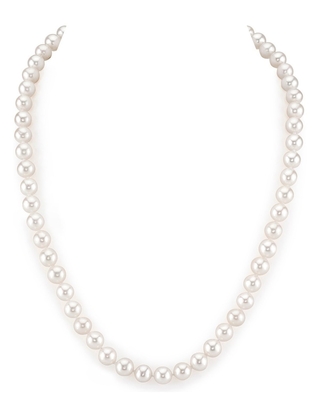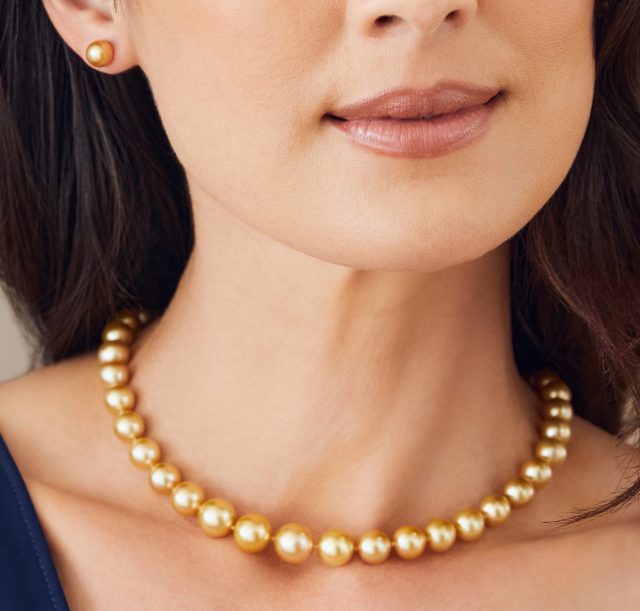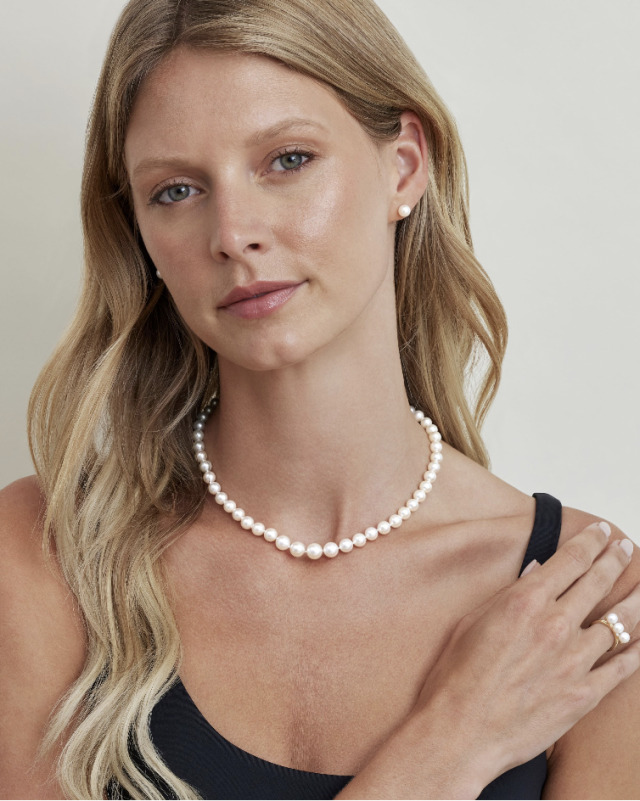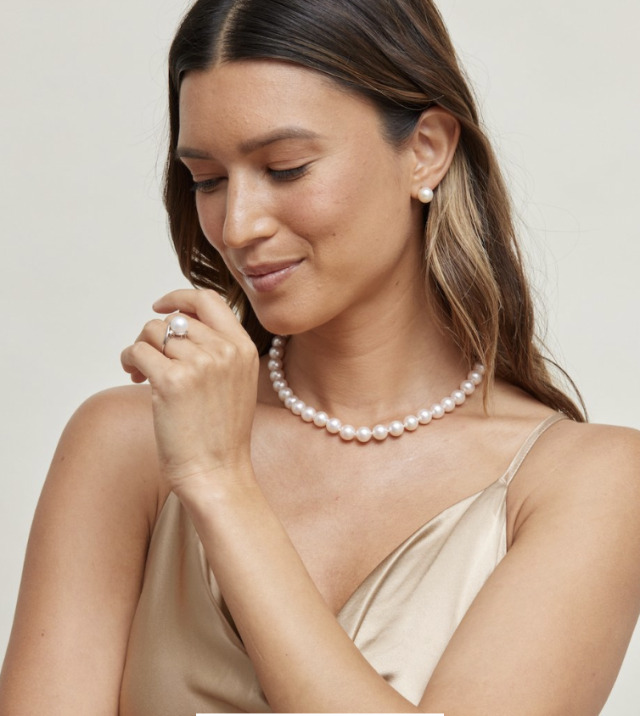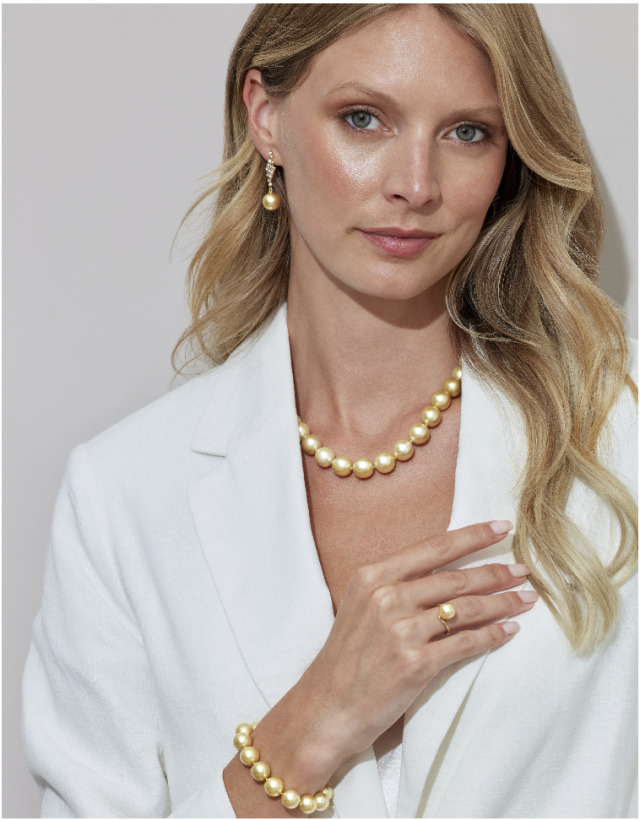THE ORIGIN OF PEARLS
Delicate yet resilient, luminous yet organic—pearls are unlike any other gemstone. The origin of pearls is fascinating, as their beauty is born not from the earth, but from the sea. Whether discovered by chance in the wild or cultivated through generations of skilled craftsmanship, every pearl carries a story of transformation.
In this guide, we explore the origin of pearls in all their forms—from the natural processes that create them to the innovations that brought cultured pearls to the world stage. We’ll walk through how pearls are formed and the key types you’ll encounter. We’ll also cover why sustainable pearl farming is essential to preserving both marine ecosystems and the future of fine jewelry.

Introduction to Pearls
Among the world’s most cherished gemstones, pearls stand apart—not only for their luminous beauty, but for their extraordinary origin. Unlike minerals mined from the earth, the origin of pearls are living organisms such as oysters and mussels, a process that lends them their organic charm and enduring allure. For thousands of years, they have been symbols of elegance, purity, and prestige.
Pearls come in several forms, each with its own story and appeal. Natural pearls, formed entirely without human intervention, are exceedingly rare and historically reserved for royalty and collectors. Cultured pearls are cultivated by carefully introducing an irritant into the mollusk to initiate nacre formation. Imitation pearls, meanwhile, are made from materials like glass or resin to replicate the look of real pearls at a lower cost. Whether natural, cultured, or imitation, pearls remain a timeless choice—each type offering a unique expression of beauty and refinement.
Historical Significance of Pearls
For thousands of years, pearls have captivated cultures across the globe. In ancient Mesopotamia, they were buried with the dead as symbols of purity and protection. In China, pearls represented wisdom and prosperity. And in the Roman Empire, they were so prized that laws restricted their wear to the elite. Long before diamonds were popularized, natural pearls were considered the ultimate luxury—formed by chance and discovered through dangerous, labor-intensive diving. Their rarity made them treasured heirlooms, exchanged between empires and immortalized in art, religion, and mythology.
Perhaps the most iconic example is La Peregrina—a perfectly symmetrical natural pearl discovered in the 1500s. It was gifted to Spanish royalty, and later famously worn by Elizabeth Taylor. Its journey from shipwrecked treasure to red carpet elegance reflects the enduring power of the pearl: a gem shaped by nature, coveted by history, and embraced by generations. Whether worn by queens or style icons, pearls remain timeless symbols of grace, refinement, and human fascination with beauty born from the sea.
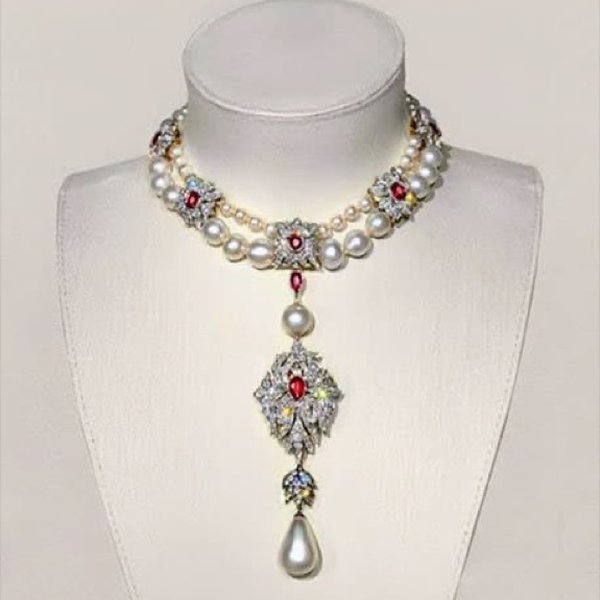 La Peregrina sold in a 2011 Christie’s New York auction for $11.8 million.
La Peregrina sold in a 2011 Christie’s New York auction for $11.8 million.
The Natural Formation of Pearls
The story of a natural pearl begins with a small, unexpected intrusion. When a foreign particle—such as a grain of sand or parasite—finds its way inside an oyster or mussel, the mollusk’s mantle tissue responds by coating the irritant with layers of nacre. This is a luminous substance, also known as mother-of-pearl.
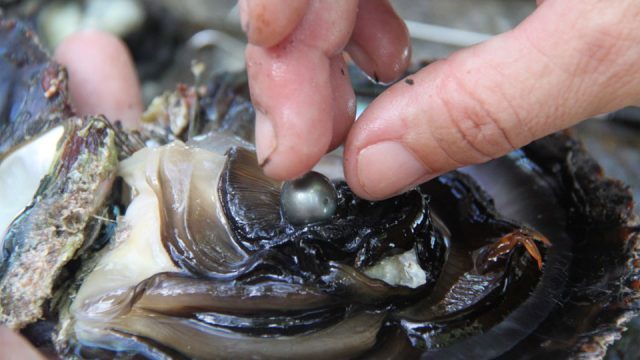
Nacre is composed of calcium carbonate and organic proteins, the same materials that form the inner lining of the shell. Layer by layer, the mollusk encases the irritant, slowly building what will become a pearl in a process that can take several years. And because it occurs without any human intervention, the result is both rare and remarkable.
Natural pearls are a true marvel of the sea: entirely organic, formed by chance, and cherished for their irregular beauty and soft, inner glow. Their formation is a quiet act of resilience—an ancient and intricate process that has captivated cultures around the world for millennia.
The Evolution of Cultured Pearls
Before the development of cultured pearls, natural pearls were an extraordinary rarity. So rare, in fact, that finding one was akin to uncovering buried treasure. But everything changed in the early 20th century, when Japanese innovators pioneered a technique to cultivate pearls with precision and care. This breakthrough made farmed pearls more accessible without sacrificing beauty or authenticity, significantly impacting the commercial jewelry market.
Today, over 99% of the pearls available worldwide are cultured, grown in carefully controlled environments that mimic nature’s process. These pearls are still formed by mollusks and made of genuine nacre. However, what sets them apart is that humans help initiate the formation, often by implanting a shell bead, which initiates the secretion of nacre that ultimately surrounds the bead. This shift has not only transformed the global pearl industry but also allowed people around the world to enjoy the timeless elegance of pearls.
Cultured pearls come in four main types—Akoya, Freshwater, Tahitian, and South Sea—each with its own distinct origin, color palette, and appeal.
Akoya Cultured Pearls
The story of Akoya cultured pearls is a tale of innovation and perseverance. The first successful round cultured pearls were produced in the early 1900s, thanks to the efforts of Japanese researchers. Mikimoto’s advances in Akoya pearl cultivation began in the early 20th century, leading to the mass production of these pearls. In 1916, Mikimoto received a patent for cultivating perfectly round Akoya pearls, marking a significant milestone in the pearl industry.
The establishment of the first pearl farms in the mid-20th century further revolutionized the pearl industry, ensuring sustainable and large-scale production.
A crucial development in Akoya pearl cultivation was the invention of the special grafting needle by Tatsuhei Mise in 1907. This innovation, along with the Mise-Nishikawa method for nucleating Akoya pearl oysters, revolutionized the process. Today, Japan remains the primary source of Akoya cultured pearls, known for their exceptional quality and luster.
Freshwater Cultured Pearls
Freshwater pearls owe much of their popularity to the innovations by Chinese farmers. China is now the largest global producer of freshwater pearls, with significant production in the Yangtze River basin. Initially, the market was flooded with ‘Rice Krispie’ pearls, which were small and irregularly shaped. However, advancements in freshwater pearl farming have significantly improved their quality, allowing them to compete with higher-end saltwater varieties.
Freshwater pearls grow typically produced using freshwater mussels, which can produce between 6 to 120 pearls per mussel. The size of a freshwater pearl is determined by the time it spends in the water. Recent techniques now enable the production of whole, round cultured freshwater pearls that rival Akoya pearls in size and quality. These perfectly round pearls come in a variety of natural pearl colors, including unique pearls, white, cream, pastel tones, peach, pink, and purple.
Tahitian Cultured Pearls
Tahitian pearls are as bold as they are beautiful. Cultured in the warm lagoons of the French Polynesian islands—primarily around Tahiti—these pearls are produced by the black-lipped oyster. The French Polynesian islands have a rich history and cultural significance in pearl cultivation, influenced by Polynesian mythology and the impact of French colonization on pearl harvesting practices.
Each oyster typically produces just one or two pearls in its lifetime, adding to the rarity and prestige of these gems. Tahitian pearls are celebrated for their alluring colors, which range from deep charcoal and silver to peacock green, aubergine, and midnight black. Their size usually falls between 8mm and 14mm. Their dramatic appearance makes them a favorite for statement pieces and contemporary pearl jewelry.
South Sea Cultured Pearls
South Sea pearls are among the largest and most valuable cultured pearls, known for their size and luster. These pearls are primarily produced in regions like Australia, the Philippines, and Indonesia. The Pinctada maxima oyster, found in these areas, is responsible for the production of both white and golden South Sea pearls.
The exceptional quality and size of South Sea pearls make them highly sought after in the jewelry market and the pearl market, especially gem quality pearls.
Pearl Farming Techniques
Pearl farming is a meticulous process that differs significantly between freshwater and saltwater pearls. Freshwater pearls are grown in mussels found in rivers and lakes, while saltwater pearls are cultivated in oysters raised in ocean-based farms. While saltwater oysters typically produce one pearl at a time, freshwater mussels can yield up to 30 pearls in a single cycle. This contributes to greater variation in shape, size, and color.
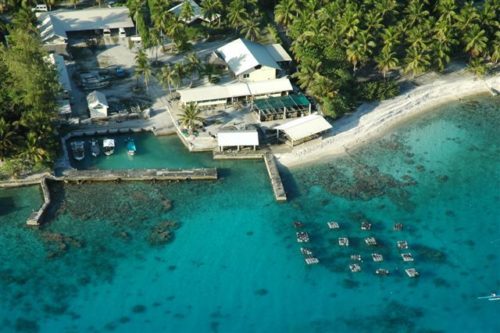 Tahitian pearl farm
Tahitian pearl farm
Pearls are produced within the soft tissue of living shelled mollusks. This soft tissue plays a crucial role in the development of pearls, both natural and cultured. Organic material decomposes during the pearl production process, leading to the creation of gas that expands between layers of nacre and results in their irregular shapes.
Sustainability is central to successful pearl farming. Clean, nutrient-rich water is essential for mollusk health, making environmentally responsible practices not just ethical but practical. These include organic farming methods, selective breeding to increase resilience to climate stressors, and careful monitoring of aquatic ecosystems.
Engaging local communities is another vital element. In many regions, pearl farming supports traditional livelihoods and fosters environmental stewardship. Sustainable operations create jobs, preserve cultural heritage, and help ensure that both pearls and their ecosystems continue to thrive.
The Role of Pearl Farmers
Modern pearl farmers are stewards of both their craft and the marine environments that sustain it. Their work centers on ethical, sustainable practices designed to protect oyster health and ocean biodiversity.
High-density oyster stocking and poor environmental oversight can degrade water quality and threaten mollusk survival. Responsible farms avoid these pitfalls by maintaining balanced ecosystems, often banning fishing in cultivation zones and using minimal intervention methods.
By fostering healthier aquatic environments, pearl farmers not only produce higher-quality pearls but also support broader marine life. Their role is essential in preserving the delicate balance between nature and one of the world’s most treasured organic gems.
Key Locations for Pearl Production
- Japan is renowned for its Akoya pearls, cultivated primarily in Mie and Ehime. These pearls are prized for their luster, roundness, and heritage.
- China leads global freshwater pearl production, with extensive farms concentrated in the Yangtze River basin.
- French Polynesia is home to the black-lipped oyster, which produces luminous Tahitian pearls in a range of dark, iridescent hues.
- Australia is famed for White South Sea pearls, particularly those produced near Broome, known for their size and satin-like luster.
- The Philippines and Indonesia are major sources of Golden South Sea pearls. Indonesia also produces smaller white and cream-toned varieties.
Pearls are found in various locations around the world, each offering unique attributes and harvesting processes. Saltwater pearls grow specifically in oysters located in protected ocean inlets, contrasting with freshwater pearls that grow in mussels in rivers and lakes. Each region’s unique environment influences the size, tone, and character of the pearls it yields.
Environmental Impact on Pearl Production
Today, climate change presents growing challenges to pearl farming. Rising sea temperatures, ocean acidification, and shifts in plankton availability can disrupt the health of mollusks and the formation of nacre layers, which are crucial for determining the quality and durability of pearls.
In low-lying island nations like French Polynesia, rising sea levels also pose a threat to farming infrastructure and coastal ecosystems. Pearls are considered precious gems, valued for their unique origin from the sea and their historical and cultural significance.
Sustainable pearl farms are adapting through innovations like selective breeding, environmental monitoring, and regenerative aquaculture. These efforts not only protect the future of pearl production but also contribute to the broader health of our oceans.
Frequently Asked Questions
What triggers the formation of natural pearls?
Natural pearls are formed when an irritant, such as a grain of sand, enters an oyster or mussel, prompting the mollusk to produce layers of nacre to protect itself. This defensive response ultimately results in the creation of a pearl.
How do cultured pearls differ from natural pearls?
Cultured pearls are distinct from natural pearls in that they are created through human intervention, whereas natural pearls develop without any human influence. This fundamental difference affects their origin and value.
What are the main types of cultured pearls?
The main types of cultured pearls are Akoya, Tahitian, Freshwater, and South Sea pearls. Each type varies in characteristics such as size, shape, and color, contributing to their unique appeal.
Why is sustainable pearl farming important?
Sustainable pearl farming is essential for safeguarding marine ecosystems, promoting the health of oyster populations, and supporting local communities through job creation. This approach not only benefits the environment but also enhances economic stability for those involved.
How does climate change impact pearl production?
Climate change significantly impacts pearl production by altering water temperatures and ocean conditions, which can affect the quality and yield of pearls. Consequently, these environmental changes pose challenges for sustainable pearl farming practices.
Final Thoughts
The journey of a pearl—from its organic beginnings inside an oyster to its place in a cherished piece of jewelry—is a story of transformation, patience, and beauty.
Thanks to the evolution of cultured pearl farming and the commitment of responsible producers worldwide, these extraordinary gems are more accessible than ever—without compromising their natural integrity. Understanding how pearls are formed, graded, and sourced allows us to appreciate their allure on a deeper level.
As we look ahead, supporting ethical and sustainable pearl practices helps ensure that this timeless treasure continues to shine—for generations to come.
